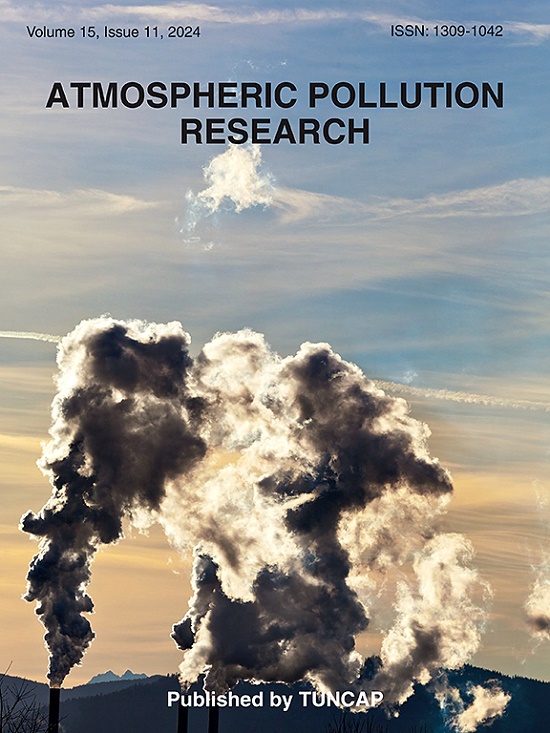利用可解释的机器学习评估人为驱动因素和气象因素对山东省空气污染物的影响
IF 3.5
3区 环境科学与生态学
Q2 ENVIRONMENTAL SCIENCES
引用次数: 0
摘要
新冠肺炎防控期间华北平原的意外雾霾被视为探索气象对PM2.5污染形成影响的天然窗口,但在量化天气要素的贡献方面存在局限性。在这项研究中,使用2015年至2020年中国山东省16个省会城市的六种空气污染物(包括PM2.5, PM10, SO2, NO2, O3和CO)和六种气象因子(包括温度,压力,相对湿度(RH),风速(WS),风向(WD)和降水)的日常数据来驱动机器学习和SHapley加性解释(SHAP)模型。通过应用这些模型,研究了人为驱动因素对污染物减排的贡献和气象因子对雾霾事件的贡献。结果表明,新冠肺炎防控措施使北京NO2、PM2.5、PM10、CO和SO2的浓度分别下降了52.1%、40.0%、45.5%、29.4%和38.7%。平均而言,O3增加了18.9%。霾期PM2.5污染主要受温度驱动,其SHAP值为19.7 μg/m3,其次是湿度(5.8 μg/m3)、降水(0.9 μg/m3)、WD (0.3 μg/m3)、气压(0.1 μg/m3)和WS (0.1 μg/m3)。与霾后相比,高压系统加上较低的温度和减弱的地面风阻碍了PM2.5的扩散,而较高的相对湿度有利于霾期PM2.5的产生。这项研究强调了排放、气象条件和空气污染监管措施之间复杂的相互作用,通过空气污染预测为未来的空气质量管理策略提供了重要见解。本文章由计算机程序翻译,如有差异,请以英文原文为准。
Evaluating the impact of anthropogenic drivers and meteorological factors on air pollutants by explainable machine learning in Shandong Province, China
Unexpected haze in North China Plain during the COVID-19 lockdown has been regarded as a natural window to explore the meteorological impact on formatting PM2.5 pollution but with limitations in quantifying weather elements’ contributions. In this study, daily data of six air pollutants (including PM2.5, PM10, SO2, NO2, O3, and CO) and six meteorological factors (including temperature, pressure, relative humidity (RH), wind speed (WS), wind direction (WD), and precipitation) from 2015 to 2020 across 16 capital cities in Shandong province, China, was used to drive the Machine Learning and the SHapley Additive exPlanation (SHAP) models. By applying these models, contributions from anthropogenic drivers to pollutant reductions and contributions from meteorological factors to the haze event were investigated. Results show that the COVID-19 lockdown measures reduced concentrations of NO2, PM2.5, PM10, CO and SO2 by −52.1 %, −40.0 %, −45.5 %, −29.4 % and −38.7 % respectively. On average, an 18.9 % increase in O3 was observed. PM2.5 pollution was mainly driven by temperature with a SHAP value of 19.7 μg/m3, followed by RH (5.8 μg/m3), precipitation (0.9 μg/m3), WD (0.3 μg/m3), pressure (0.1 μg/m3) and WS (0.1 μg/m3) during the haze period. Relative to the post-haze period, high-pressure systems coupled with lower temperatures and weakened surface winds hindered the dispersion of PM2.5 whilst higher RH was in favour of PM2.5 production during the haze period. This study underscores the intricate interplay between emissions, meteorological conditions, and regulatory measures in air pollution, offering critical insights into future air quality management strategies by air pollution prediction.
求助全文
通过发布文献求助,成功后即可免费获取论文全文。
去求助
来源期刊

Atmospheric Pollution Research
ENVIRONMENTAL SCIENCES-
CiteScore
8.30
自引率
6.70%
发文量
256
审稿时长
36 days
期刊介绍:
Atmospheric Pollution Research (APR) is an international journal designed for the publication of articles on air pollution. Papers should present novel experimental results, theory and modeling of air pollution on local, regional, or global scales. Areas covered are research on inorganic, organic, and persistent organic air pollutants, air quality monitoring, air quality management, atmospheric dispersion and transport, air-surface (soil, water, and vegetation) exchange of pollutants, dry and wet deposition, indoor air quality, exposure assessment, health effects, satellite measurements, natural emissions, atmospheric chemistry, greenhouse gases, and effects on climate change.
 求助内容:
求助内容: 应助结果提醒方式:
应助结果提醒方式:


